-
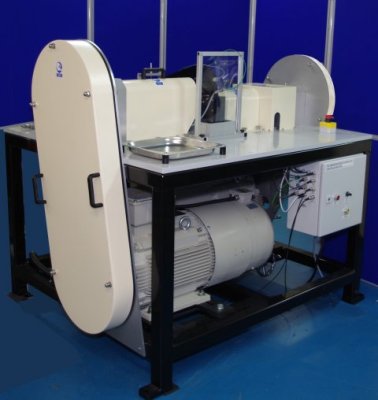
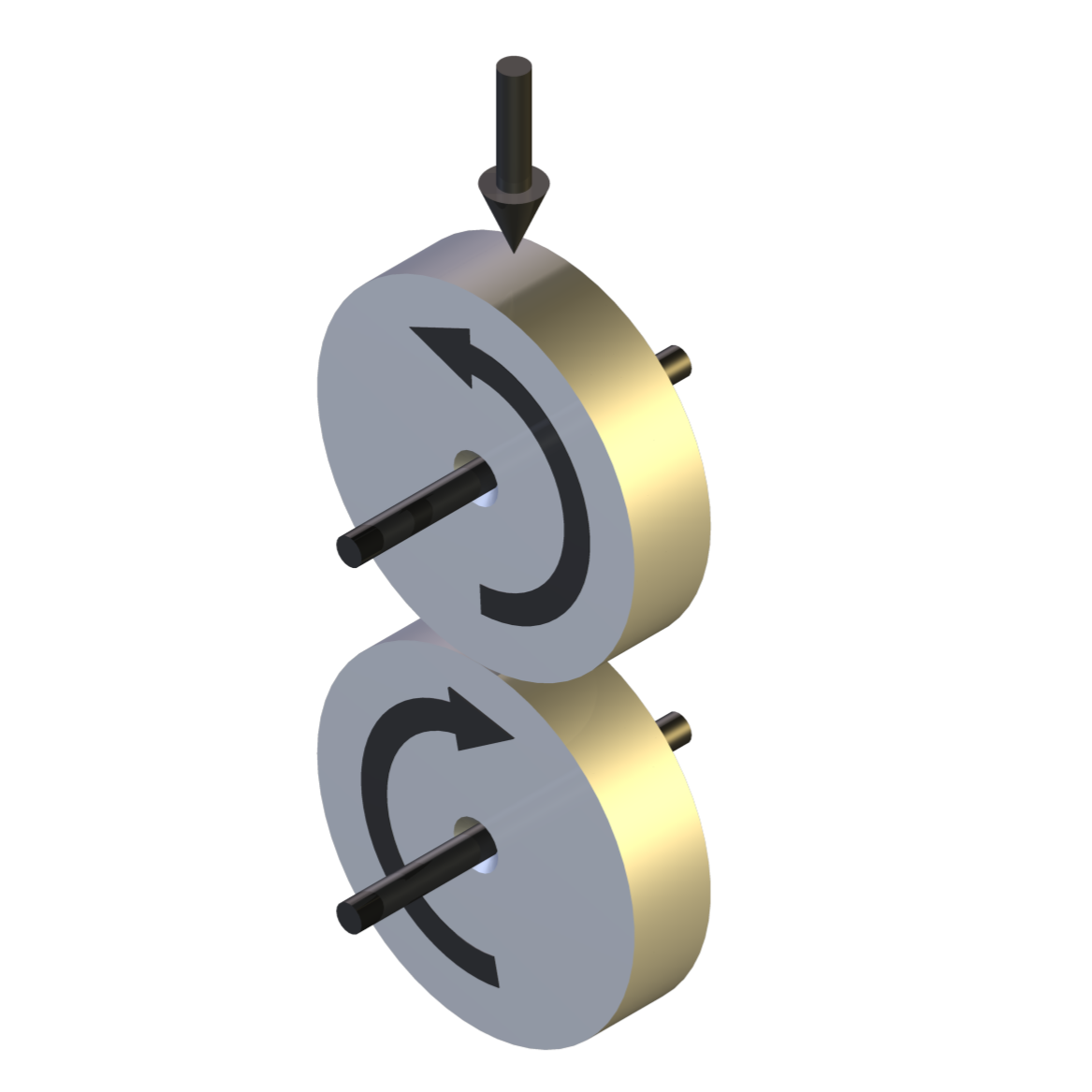
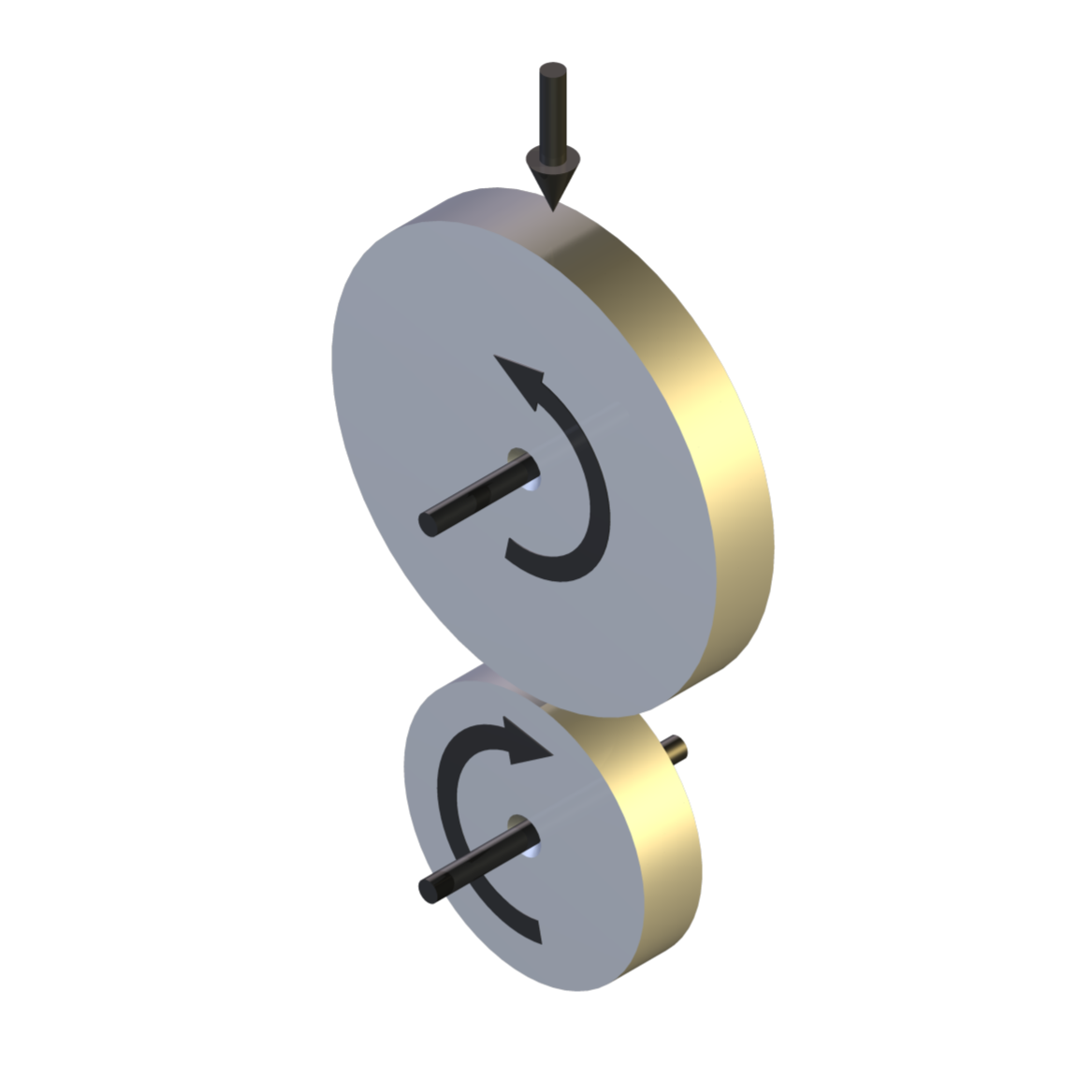
General Description
The TE 74 Two Roller Machine has two motors, one to provide the input power and one to absorb the transmitted power. To achieve the high loads with small diameter rollers, hence high contact pressures, the test rollers are mounted on shafts with bearings on either side, in the “fully supported” configuration. As a consequence, spindle bearings are exposed to, and must run in, the test lubricant.
To achieve satisfactory performance in line contact, the mounting/loading arrangement has adjustable alignment, with the upper specimen shaft carried on a pivoted arm and with a spherical bearing incorporated in the pivot axle. Axial alignment is achieved by indexing the pivot axle. Loading is achieved by means of a servo controlled pneumatic bellows actuator with force transducer feedback.
The lower specimen shaft is carried in fixed bearings. The drive to the lower roller incorporates an in-line torque transducer for measuring the input torque to the system. It should be noted that the traction measurement is thus subject to parasitic losses associated with the roller spindle bearings. These losses are small but may be quantified by running the unit under conditions of zero slip at different speeds and temperatures.
A vibration sensor is provided for detecting surface failure. The upper roller housing is electrically insulated and slip rings are provided on the roller shafts for electrical contact resistance measurement.
A lubricant service module is fitted as standard incorporating a sump tank with immersion heater, delivery pump, scavenge pump and oil to water heat exchangers for cooling.
The motors are a.c. and powered by vector drives allowing precise control of speed. Power is re-circulated electrically via a common d.c. link between the drives, upstream of the frequency inverter stages. Total power requirement is thus limited to the system losses. For control purposes, one drive is designated as master with the second drive deriving its speed set point, adjusted for the required slip ratio, from the master drive.Design Variants
Two versions of the machine are available. The TE 74S (standard capacity) incorporates two 7.5 kW motors, a shaft centre distance of 40 mm and 12 kN loading system, whereas the TE 74H (high capacity) has two 30 kW motors, a shaft centre distance of 70 mm and 30 kN loading system.
Drive Configuration:
The lower roller spindle is connected to an in-line torque transducer via a cardan shaft; the transducer is connected to a lay shaft by a coupling and the lay shaft connected to the motor by pulley and timing belt. The upper roller spindle is connected to a lay shaft by a cardan shaft and the lay shaft connected to its motor by pulley and belt drive.
Control and Data Acquisition
Control and data acquisition are implemented via host PC running COMPEND 2020 Windows compatible software, in conjunction with a Phoenix Tribology USB micro-controller interface.
Automatic control is implemented via user programmable test sequences. Manual control is implemented using on screen toggles. Data is stored to hard disc in either .csv or .tsv file formats.Operating Envelope – TE 74S
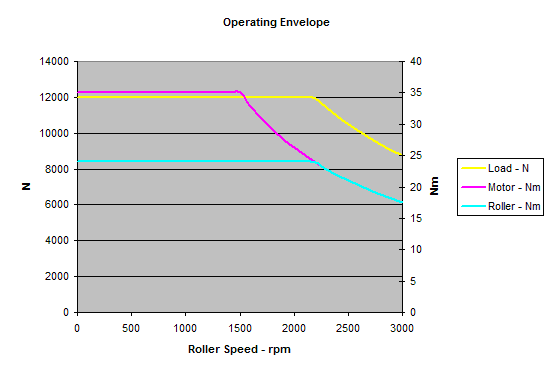
Characteristic showing motor torque-speed characteristic (available torque) compared with roller generated torque, assuming traction coefficient of 0.1, with corresponding reduction in applied load. Note that the full load can be applied at full speed in pure rolling or under conditions where the traction coefficient is less than 0.07.
Assuming 40 mm diameter rollers and traction coefficient of 0.1, the maximum permissible load at maximum speed is 8.7 kN.
Note that as the minimum specimen diameter is 15 mm, a diameter of greater than this is required for a crowned roller sample machined on a 15 mm shaft. The practical minimum diameter for a crowned roller is thus 20 mm.Operating Envelope – TE 74H
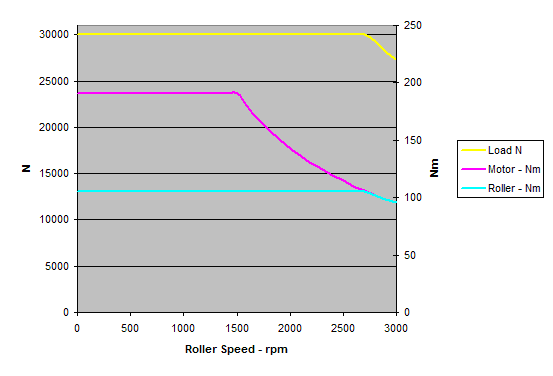
Characteristic showing motor torque-speed characteristic (available torque) compared with roller generated torque, assuming traction coefficient of 0.1, with corresponding reduction in applied load. Note that the full load can be applied at full speed in pure rolling or under conditions where the traction coefficient is less than 0.08.
Assuming 70 mm diameter rollers and traction coefficient of 0.1, the maximum permissible load at maximum speed is 27.3 kN.
Note that as the minimum specimen diameter is 30 mm, a diameter of greater than this is required for a crowned roller sample machined on a 30 mm shaft. The practical minimum diameter for a crowned roller is thus 40 mm. -
Technical Specifications
Technical Specifications – TE 74S
Type: Circulating power Fully supported roller Spindles adjacent Fixed shaft centre distance Contact: Line or point contact Test Conditions: Pure Rolling Sliding/Rolling Environment: Lubricated Standard Roller Diameters: 40 mm on 40 mm Maximum Roller Difference: 65 mm on 15 mm Maximum Roller Thickness: 12 mm Shaft Centre Distance: 40 mm Maximum Load: 12 kN Roller Temperature: Ambient to 150°C Motor Power: 7.5 kW @ 1500 rpm Motor Maximum Speed: 3000 rpm Maximum Roller Speed: 6000 rpm with 2:1 Belt Ratio Drive Ratios: 2:1, 1:1, 1:2 Maximum Torque 2:1 Belt Ratio: 24 Nm @ 3000 rpm Maximum Torque 2:1 Belt Ratio: 12 Nm @ 6000 rpm Maximum Torque 1:1 Belt Ratio: 48 Nm @ 1500 rpm Maximum Torque 1:2 Belt Ratio: 96 Nm @ 750 rpm Controlled Parameters Motor speed Motor speed difference Applied load Test fluid temperature Test duration Measured Parameters Motor speed Motor speed difference Applied load Transmitted torque Lubricant inlet temperature Test bath outlet temperature Vibration sensor output Electrical contact resistance Services Electricity: 380/415V, three phase plus neutral, 50/60 Hz, 15 kW Clean, dry air: 4 cfm at 8 bar (120 psi) Mains water and drain: 10 l/min (typical) Technical Specifications – TE 74H
Type: Circulating power Fully supported roller Spindles adjacent Fixed shaft centre distance Contact: Line or point contact Test Conditions: Pure Rolling Sliding/Rolling Environment: Lubricated Standard Roller Diameters: 70 mm on 70 mm Maximum Roller Difference: 110 mm on 30 mm Maximum Roller Thickness: 12 mm Shaft Centre Distance: 70 mm Maximum Load: 30 kN Roller Temperature: Ambient to 150°C Motor Power: 30 kW @ 1500 rpm Motor Maximum Speed: 3000 rpm Maximum Roller Speed: 6000 rpm with 2:1 Belt Ratio Drive Ratios: 1:1, 2:1 Maximum Torque 1:1 Belt Ratio: 192 Nm @ 1500 rpm Maximum Torque 1:1 Belt Ratio: 96 Nm @ 3000 rpm Maximum Torque 2:1 Belt Ratio: 96 Nm @ 3000 rpm Maximum Torque 2:1 Belt Ratio: 48 Nm @ 6000 rpm Controlled Parameters Motor speed Motor speed difference Applied load Test fluid temperature Test duration Measured Parameters Motor speed Motor speed difference Applied load Transmitted torque Lubricant inlet temperature Test bath outlet temperature Vibration sensor output Electrical contact resistance Services Electricity: 380/415V, three phase plus neutral, 50/60 Hz, 75 kW Clean, dry air: 4 cfm at 8 bar (120 psi) Mains water and drain: 10 l/min (typical) -
Index Tags
-
Download the Machine Leaflet
Call us on +44 (0) 1635 298279
Email : info@phoenix-tribology.com
Email : info@phoenix-tribology.com

